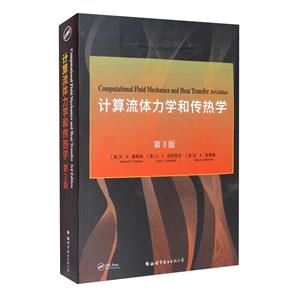-
>
宇宙、量子和人類心靈
-
>
氣候文明史
-
>
南極100天
-
>
考研數(shù)學專題練1200題
-
>
希格斯:“上帝粒子”的發(fā)明與發(fā)現(xiàn)
-
>
神農架疊層石:10多億年前遠古海洋微生物建造的大堡礁
-
>
聲音簡史
Computational fluid mechanics and heat transfer 版權信息
- ISBN:9787519283223
- 條形碼:9787519283223 ; 978-7-5192-8322-3
- 裝幀:一般膠版紙
- 冊數(shù):暫無
- 重量:暫無
- 所屬分類:>>
Computational fluid mechanics and heat transfer 內容簡介
Another 15 years have gone by since the second edition of this text appeared.During this period,the rate of development in algorithms has slowed compared to any earlier period,but the increase in computational power has been astounding and shows no sign of slowing.Desktop computers can outperform the supercomputers of the early 1990s.The rate ofimprovement of computing power is such that a problem that required a year of computing time to solve 10 years ago can now be solved overnight.The increase in computing power has enabled engineers to solve more complete equa-tions and complex geometries for aerodynamic flows,i.e.,use less physical modeling and fewer approximations.It has also motivated efforts to compute more complex physical phenomena such as turbulence and multiphase fiows. Another clear trend is the increasing use of commercial software for computational fiuid dynamics (CFD) applications.In the early days,CFD was mostly a do-it-yourself enterprise.It is more likely now that a CFD code is thought of as representing a large investment,and companies do not launch into writ-ing a new one without considerable thought.lt is more likely that CFD engineers will become involved in modifying or extending an existing code than in writing a new code from "scratch." However,even making modifications to CFD codes requires knowledge of algorithms,general numerical strategies,and programming skills.The text promotes programming skills by explaining algorithm details and including homework problems that require programming.Even those engineers that will utilize com-mercial codes and be responsible for interpreting the results will be better prepared as a result of the knowledge and insight gained from developing codes themselves.It is very important for engineers to know the limitations of codes and to recognize when the results are not plausible.This will not change in the future.The experience gained by writing and debugging codes will contribute toward the matu-rity needed to wisely use and interpret results from CFD codes. It is essential that courses evolve as technology advances and new knowledge comes forth.However,not every new twist will have a permanent impact on the discipline,F(xiàn)ads die out,and some numerical approaches will become obsolete as computing power relentlessly advances.The authors have included a number of new developments in this edition while preserving the funda-mental elements of the discipline covered in earlier editions.A number ofideas and algorithms that are now less frequently utilized due to advances in computer hardware or numerical algorithms are retained so that students and instructors can gain a historical perspective of the discipline.Such material can be utilized at the discretion of the instructor.Thirty-four new homework problems have been added bringing the total number of homework problems to 376. We have retained the two-part,ten-chapter format of the text.Additions and clarifications have been made in all chapters.Part I,consisting of Chapters 1 through 4,deals with the basic concepts and fundamentals of the finite-difference and finite-volume methods.The historical perspective in Chapter 1 has been expanded.The sections on the finite-volume method in Chapter 3 have been revised and expanded.The conjugate gradient and generalized minimal residual (GMRES) meth-ods are now discussed in the section on Laplace's equation in Chapter 4.Part II,consisting of Chapters 5 through 10,covers applications to the equations of fluid mechanics and heat transfer.The governing equations are presented in Chapter 5.The equations for magnetohydrodynamic (MHD)flows and the quasi-one-dimensional form of the Euler equations are now included.Turbulence modeling has been updated.The coverage of large-eddy simulation (LES) has been expanded and detached eddy simulation (DES) has been introduced.In Chapter 8,the material on the parabolized Navier-Stokes (PNS) equations has been expanded to include methods for handling flow fields with significant upstream influences,including large streamwise separated regions.A number of updates and additions are found in Chapter 9.Coverage of Runge-Kutta schemes,residual smoothing,and the lower-upper symmetric Gauss-Seidel (LU-SGS) scheme have been expanded.Some recent vari-ations in time-accurate implicit schemes are also included.
Computational fluid mechanics and heat transfer 目錄
Preface to the Second Edition
Preface to the First Edition
Authors
PART Ⅰ Fundamentals
Chapter 1 Introduction
1.1 General Remarks
1.2 Comparison of Experimental, Theoretical,and Computational Approaches
1.3 Historical Perspective
Chapter 2 Partial Differential Equations
2.1 Introduction
2.1.1 Partial Differential Equations
2.2 Physical Classification
2.2.1 Equilibrium Problems
2.2.2 Eigenvalue Problems
2.2.3 Marching Problems
2.3 Mathematical Classification
2.3.1 Hyperbolic PDEs
2.3.2 Parabolic PDEs
2.3.3 Elliptic PDEs
2,4 Well-Posed Problem
2.5 Systems of Partial Differential Equations
2.6 Other PDEs of Interest Problems
Chapter 3 Basics of Discretization Methocls
3.1 Introduction
3.2 Finite Differences
3.3 Difference Representation of Partial Differential Equations
3.3.1 Truncation Error
3.3.2 Round-off and Discretization Errors
3.3.3 Consistency
3.3.4 Stability
3.3.5 Convergence for Marching Problems
3.3.6 Comment on Equilibrium Problems
3.3.7 Conservation Form and Conservative Property
3.4 Further Examples of Methods for Obtaining Finite-Difference Equations
3.4.1 Use of Taylor Series
……
PART Ⅱ Application of Numerical Methods to the Equations of Fluid Mechanics and Heat Transfer
Appendix A: Subroutine for Solving a Tridiagonal System of Equations
Appendix B: Subroutines for Solving Block Tridiagonal Systems of Equations
Appendix C: Modified Strongly Implicit Procedure
Nomenclature
References
Index
Computational fluid mechanics and heat transfer 作者簡介
理查德·H.普萊徹(Richard H. Pletcher),康奈爾大學博士畢業(yè),機械學教授。 J. C. 坦尼希爾(John C. Tannehill),愛荷華州艾姆斯州立大學教授,他被公認為計算流體動力學領域的先驅(CFD)。 D. A. 安德森(Dale A. Anderson),哈佛大學的名譽教授。
- >
中國歷史的瞬間
- >
羅庸西南聯(lián)大授課錄
- >
唐代進士錄
- >
史學評論
- >
企鵝口袋書系列·偉大的思想20:論自然選擇(英漢雙語)
- >
【精裝繪本】畫給孩子的中國神話
- >
名家?guī)阕x魯迅:朝花夕拾
- >
朝聞道















